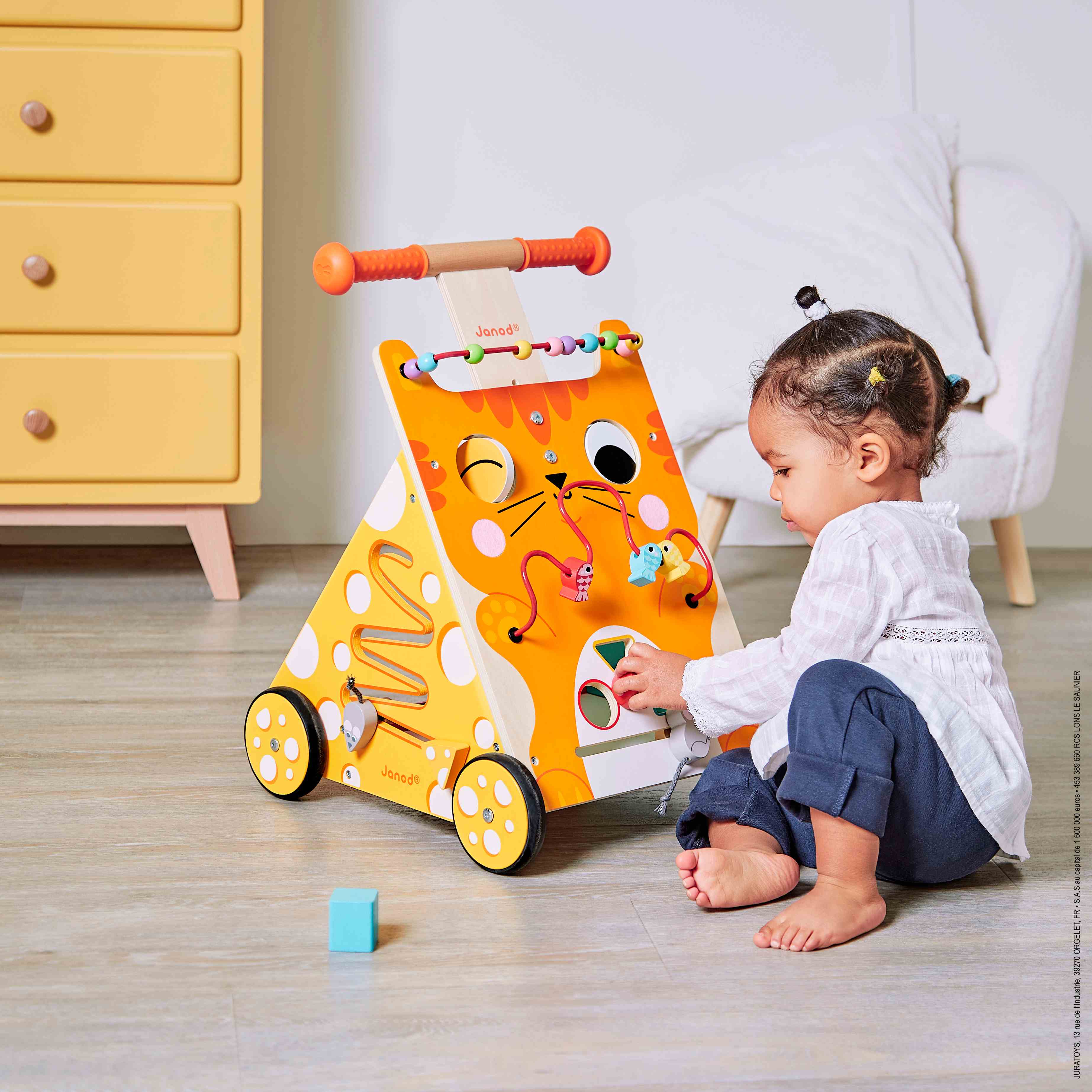To enjoy your gifts under the tree 🎄: we recommend ordering before 12/18 (France) and 12/17 (other countries)
First order? 1 free maracas dumbbell Confetti with the code BIENVENUE-JANOD
From €150 purchase: 1 free mini xylophone with the code CONFETTI25 ✨
Free delivery for purchases over €40
Free shipping from €40 of purchase 🎁
Vous devez avoir un compte pour pouvoir utiliser cette fonctionnalité.
Connexion InscriptionReading time: 25 minutes.
The baby carrier is an ideal toy for little ones discovering walking: they can sit up and move forward by pushing with their feet. Also known as a "rickshaw" or "pusher carrier", the baby carrier is often shaped like a fun vehicle or adorable animal that the child can ride. Activities are often included to stimulate little ones as young as 12 months.
The walking cart is a great toy for babies just starting to walk.from 12 months onwards, the child can stand up and push the cart as he explores! It's a toy that's often complemented by games to awaken children from the age of 1. With its walking cart, baby can go everywhere feeling reassured: he can lean on it to explore his environment.
Can't decide between a wooden carrier or a wooden walking wagon? Worried about finding the right toy for your child? Follow our guide to make the right choice and fall for baby's new companion!
It's important to bear in mind that the child must be able to sit up on his own to enjoy his carrier safely. Baby may need help from Mum or Dad to get in and out of the carrier at first. It's also possible that your little one won't master the technique of pushing forward on his feet at first, but that's no problem - his Janod carrier is an excellent way to develop his motor skills! As baby explores, he'll soon understand where to position his hands and how to move his wooden carrier forward.
Every child grows and develops at a different pace. Nevertheless, the recommended age for the baby carrier is 12 months.
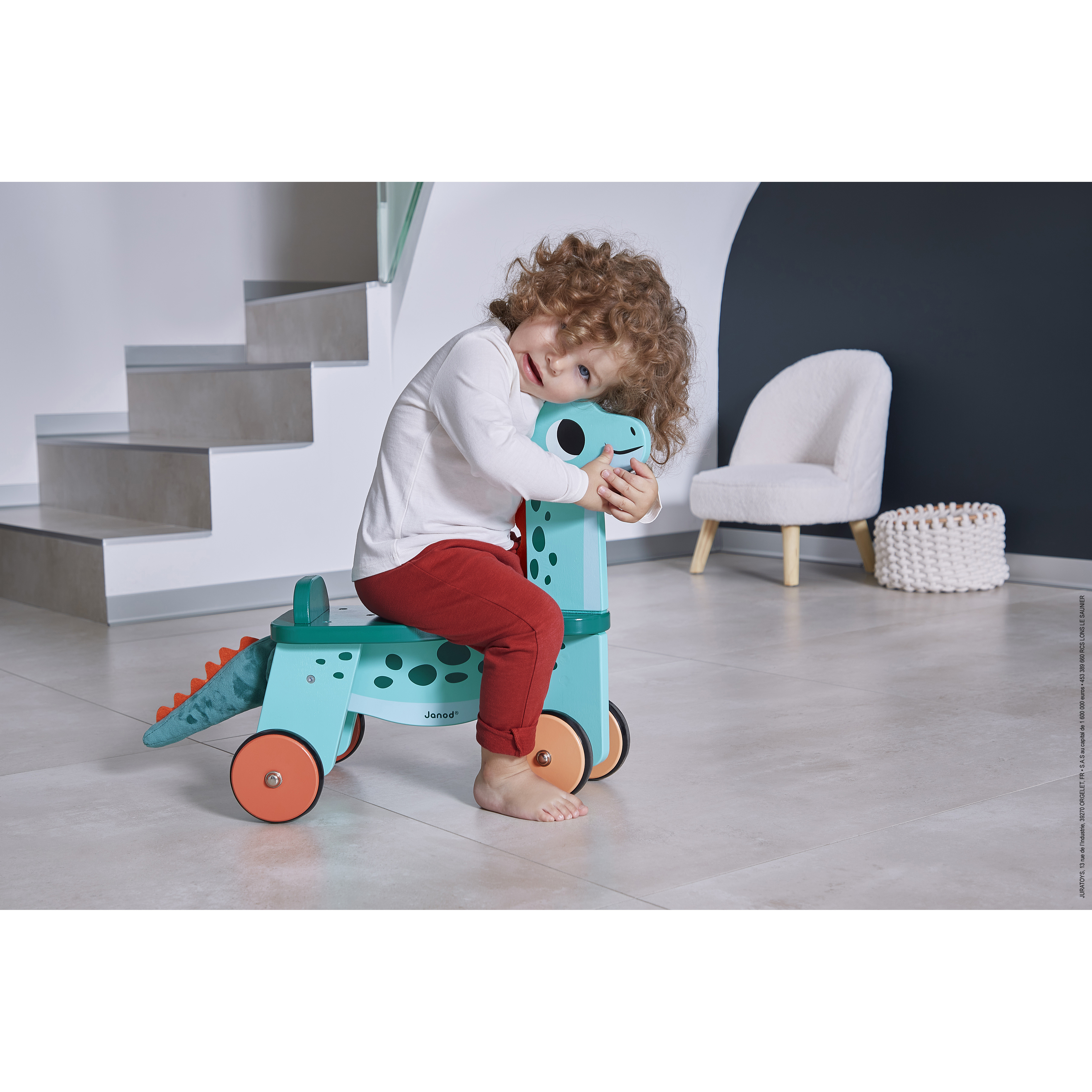
Choose a wooden carrier for a durable, charming toy that's shock-resistant and can support a maximum weight of around 20 kilos. Fox, llama, hippopotamus or panda: animal carriers are sure to delight the whole family!
A carrier for a baby aged 12 months - 1 year
If you're looking for a wooden carrier for a 1-year-old baby, choose the vehicle or animal that will appeal to your child: a mischievous-looking dinosaur carrier or a tractor carrier to play the little farmer? Most carriers designed for young children have handlebars or fixed grips, to guarantee good stability and limit the risk of falls.
The carrier is an essential part of baby's early-learning toys. It's time for him to discover movement!
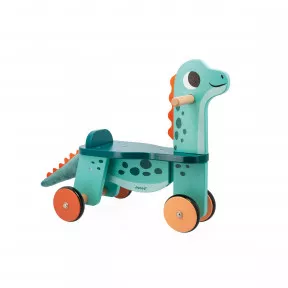
Dino - Ride On Dino Portosaurus
Make way! Our diplodocus ride-on is about to make its entrance! It goes without saying that all children will be proud to ride a dinosaur both inside and outside the house! Our round-eyed Portosaurus boasts blue hues that are enhanced with orange spikes! Its wide smile will make little ones want to go for lovely walks! Children aged 12 months and up can begin to develop their motor skills on this wooden balance bike with 4 ultra-stable wheels. The 2 front wheels move with the dinosaur's head when children want to turn. The 4 silicone-fitted wheels allow for a quieter ride. The shape of the seat (21 cm high) has been designed for children to climb on easily and sit comfortably. The natural wooden handles - protruding from the head - will help little ones stabilise themselves when going on an independent adventure, i.e. using their own legs to push! And don’t forget the surprise! The dinosaur's tail is made from an ultra-soft plush material and adds a fun touch to this ride-on! The Velcro-detachable part can be easily cleaned (hand washable at 30°C). This awesome ride-on is made from FSC® wood.
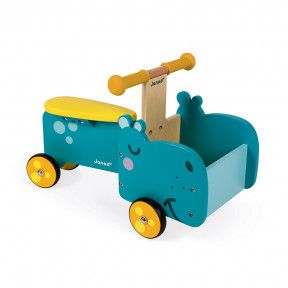
Hippopotamus Ride-On (wood)
In the mind of children, everything is allowed and riding a hippo could very well be part of it with this nice wooden ride-on! You can take your baby on his/her first outings in complete autonomy or discover new things at home on 4 wheels. Our Hippo ride-on is ideal for developing your child's motor skills and balance from 1 year old. They will gradually learn to better manage their balance while discovering the world around them. Practical, the head of the hippo is a small locker that will allow them to take toys and soft toys everywhere. What's the best thing about this ride-on? Its very original look! Our beautiful animal and its wide smile will make the little ones want to go on an adventure. The long foam seat with yellow imitation leather cover is very comfortable. The silicon handles and wheels match the seat, because when it comes to going out in style, we leave nothing to chance! The textured handles ensure an optimal grip for children's little hands. Finally, with its 4 silent rubber wheels, this wooden ride-on does not mark the ground and ensures a good and safe hold!
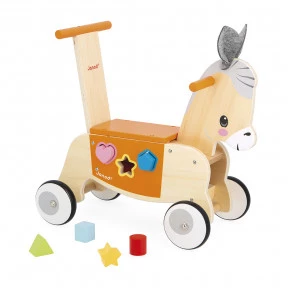
Wooden donkey carrier
Little donkey can't wait to discover the world, and neither can baby! With this wooden donkey carrier, you're on your way to new adventures, from 12 months. Come on, hu! By riding his carrier, baby develops his sense of balance and gross motor skills, while discovering his environment. Want to push your toy or be pushed? Thanks to the handle on the back! Whichever way your little one uses his carrier, he'll learn to manage his weight and have a great time. The little extra for this early-learning toy? The shape box included, with 6 shapes to insert and retrieve from the front, so you can start all over again. Perfect for practising dexterity! Last but not least, the 4 rubber wheels are quiet and provide a good grip, so you can walk around in complete peace of mind. Ideal for encouraging gross motor skills and strengthening support for walking, this wooden carrier is a real eye-catcher, with its little felt ears and soft colors. Whether your little one loves farm animals or simply trotting, he'll be delighted! This early-learning toy is made from FSC™-certified wood from sustainably managed forests.
A carrier for a baby aged 18 months - 2 years
Between 18 months and 2 years of age, children develop their motor skills on a daily basis. They start to walk and become aware of how their body moves in space. The 18-month baby carrier will be a real companion, encouraging your child to move around. The advantage of a push-chair baby carrier is that the child can alternate between standing and sitting to progress at his or her own pace.
Choose a designer baby carrier that will add a poetic touch to your baby's room, or that you'll enjoy leaving in your living room!
A carrier for a child aged 2 to 3
Between the ages of 2 and 3, children generally master walking independently. His carrier is more of a"toy carrier", with which he will enjoy walking around the house. It's a real companion! Choose carriers with at least 2 directional wheels, so that the child can steer it as he pleases, without the risk of falling.
Settle in with doudou, and let the adventure begin!

Dino - Ride On Dino Portosaurus
Make way! Our diplodocus ride-on is about to make its entrance! It goes without saying that all children will be proud to ride a dinosaur both inside and outside the house! Our round-eyed Portosaurus boasts blue hues that are enhanced with orange spikes! Its wide smile will make little ones want to go for lovely walks! Children aged 12 months and up can begin to develop their motor skills on this wooden balance bike with 4 ultra-stable wheels. The 2 front wheels move with the dinosaur's head when children want to turn. The 4 silicone-fitted wheels allow for a quieter ride. The shape of the seat (21 cm high) has been designed for children to climb on easily and sit comfortably. The natural wooden handles - protruding from the head - will help little ones stabilise themselves when going on an independent adventure, i.e. using their own legs to push! And don’t forget the surprise! The dinosaur's tail is made from an ultra-soft plush material and adds a fun touch to this ride-on! The Velcro-detachable part can be easily cleaned (hand washable at 30°C). This awesome ride-on is made from FSC® wood.

Wooden donkey carrier
Little donkey can't wait to discover the world, and neither can baby! With this wooden donkey carrier, you're on your way to new adventures, from 12 months. Come on, hu! By riding his carrier, baby develops his sense of balance and gross motor skills, while discovering his environment. Want to push your toy or be pushed? Thanks to the handle on the back! Whichever way your little one uses his carrier, he'll learn to manage his weight and have a great time. The little extra for this early-learning toy? The shape box included, with 6 shapes to insert and retrieve from the front, so you can start all over again. Perfect for practising dexterity! Last but not least, the 4 rubber wheels are quiet and provide a good grip, so you can walk around in complete peace of mind. Ideal for encouraging gross motor skills and strengthening support for walking, this wooden carrier is a real eye-catcher, with its little felt ears and soft colors. Whether your little one loves farm animals or simply trotting, he'll be delighted! This early-learning toy is made from FSC™-certified wood from sustainably managed forests.
Walking carts are generally suitable from 12 months. However, it is essential to bear in mind that each child progresses at his or her own pace. To use a wooden walking cart safely, it's important that the child knows how to stand on his own. If baby is still in the process of acquiring this skill, a Janod walking cart is always accompanied by games that baby can enjoy while he familiarizes himself with his cart.
With a Janod walking cart, baby discovers his environment by standing upright, and benefits from fun activities to help him progress in his learning to walk at his own pace, from the age of 1.
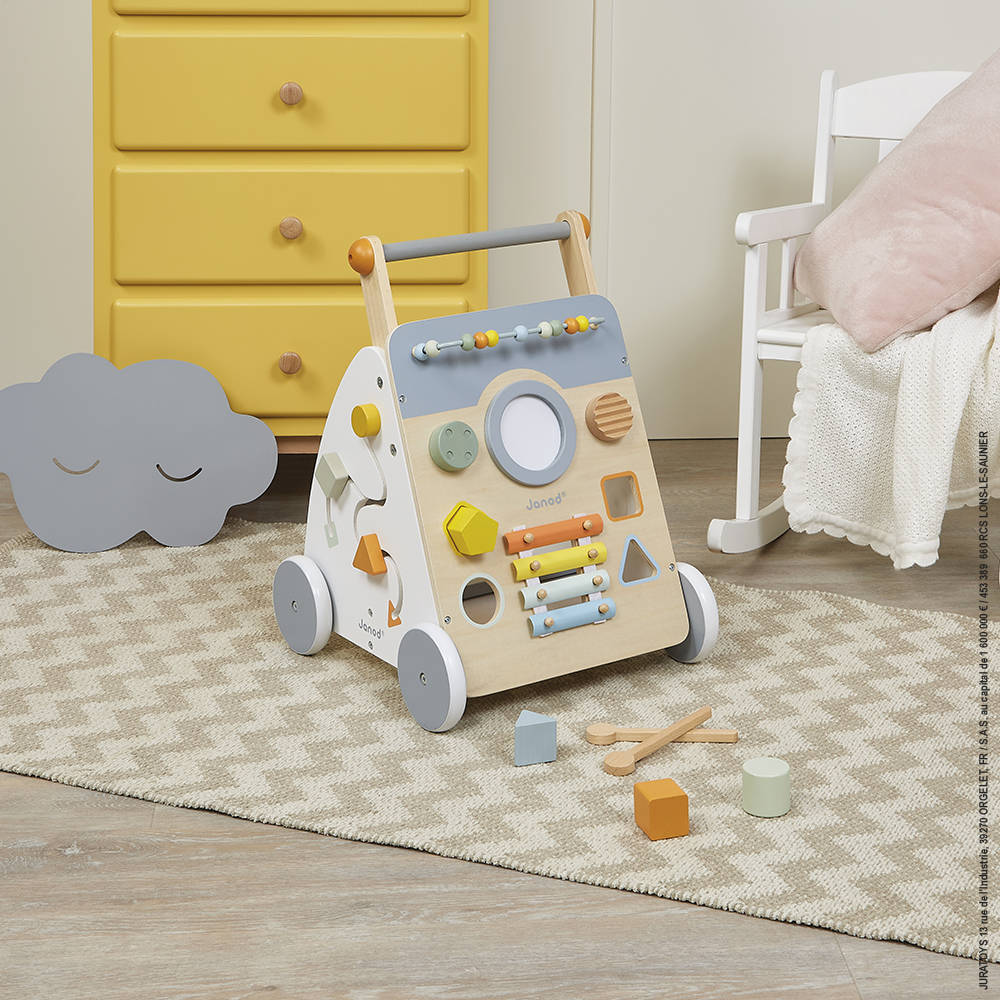
A cart for a baby aged 12 months - 1 year
A 12-month-old baby's balance can be precarious. That's why a walking cart with brake is ideal for a safe learning experience. A 1-year-old can also quickly tire of an activity. For example, he'll want to go from standing to sitting on the ground, dropping down most of the time. So, opt for an anti-tilt walking cart to prevent the toy from falling over.
A wooden walking cart with brakes is a sturdy early-learning toy that will reassure baby and his parents, for safe playtime!
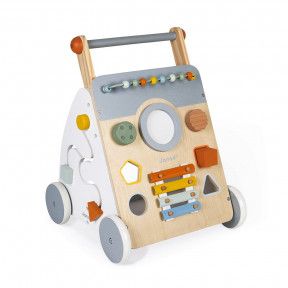
Sweet Cocoon Wooden Multi-Activity Trolley
This beautiful multi-activity push-along trolley is great for helping children learn to walk. It’s suitable for children aged 12 months and over, and comes with an invisible, removable brake that allows you to stop and release the wheels as required, so you can control the speed of the trolley as your child learns. As well as helping your child get on their feet, the trolley also gives your child 9 different ways to test their motor skills and dexterity: an abacus, a shape box, a maze, gears, a rotary switch with built-in sound, a “scratchy” button, a magnifying rotary mirror, a drum, and metal xylophone to develop their musical ear. And with its felt mat to reduce the noise of falling blocks and its silent wheels, our designers really have thought of everything! Given all that and its trendy design, you and baby are bound to love it! We love this early-years trolley’s natural wood and the white and grey colour scheme, which is accentuated by the splashes of colour that come with the nine different activities! The Sweet Cocoon collection features toys for infants with soft colours and rounded shapes, providing a wide range of fun activities that will keep babies and toddlers entertained for hours!
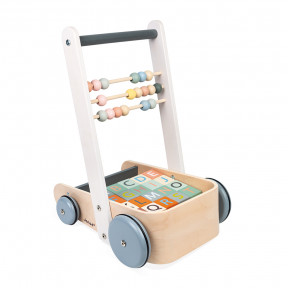
Sweet Cocoon Cart with ABC blocks
This wooden awakening cart is ideal for accompanying baby in its first steps. This cart also contains 20 cubes illustrating the letters of the alphabet, numbers and simple shapes as well as 3 rows of abacus to start counting. Thanks to a rubber part, the wheels are silent. This wooden toy is equipped with an anti-tip system. This wooden toy is part of the Sweet Cocoon collection, a delicate colors range, inspired by current trends to gently accompany your child's first learnings!
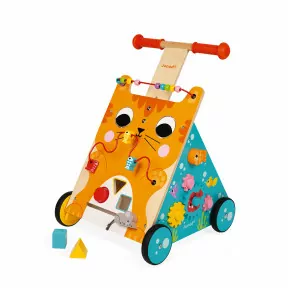
Multi-Activities Cat Baby Walker (wood)
Meooow! Make room for the cutest feline of them all! Our wide-eyed ginger cat is always ready for a walking and exploring session with baby! This wooden multi-activity baby walker will accompany children from 1 year old thanks to the many little games on its 3 sides! Have fun and develop your fine motor skills and dexterity with the 8 playful activities of our clever cat: a fish loop, a traditional shape sorter and a small mouse slider on the front, a mouse track on one side, gears and a seabed sound button on the other. To develop children's sense of touch, our cat's large eyes rotate and its cheeks are made of felt. This lovely multi-activity walker is particularly suitable for learning to walk; thanks to its height-adjustable handle (from 47 to 53 cm/18.5 to 20.9"), this walker can adapt to your child's height, and can therefore be used from 12 months to 3 years old. For more safety, it is equipped with an invisible and removable brake that allows the wheels to be locked and gradually released in order to control the speed of the walker during learning (suitable for 12 months old children). Finally, its 4 silent rubber wheels don't mark the ground! All you'll have to do is to name this new companion!
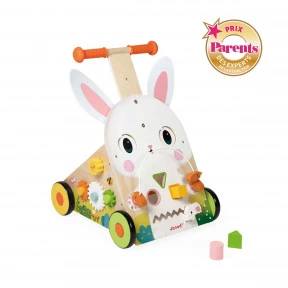
Wooden Rabbit Multi-Activity Cart
Yippee! Make way for the cutest bunny ever! Our big-eyed white bunny is always ready for a session of walking and discovery with baby! This multi-activity wooden cart is perfect for children aged 1 and over, thanks to the many little games on its 3 sides! It's all about having fun and developing fine motor skills and dexterity with our naughty rabbit's 9 playful activities: looping circuit with carrots, traditional shape box and little mouse to slide through a maze on the front, bee maze on one side, gears and sound sun on the other. Our rabbit's big eyes rotate, and his cheeks are made of felt, as are his ears, to develop the child's sense of touch. Here's a fun feature: the ears are removable thanks to Velcro fasteners, so they can be repositioned as desired! This cute activity cart is particularly well-suited to learning to walk. Thanks to its height-adjustable handle (from 46 to 53 cm), it can be adapted to your child's height. It can accompany your child from 12 months to 3 years. For safety, it's equipped with an easily adjustable brake on the wheels, which can be set in 3 positions (full lock, reduced speed, normal speed), to release them gradually and control the cart's speed as your child learns. A wooden walking cart with a brake is ideal for peaceful strolls. Finally, it has 4 silent rubber wheels. Offering baby a walking cart means he can learn to walk with confidence and at his own pace: alternating between walking and a variety of games, he learns to master his environment and never tires of the activities on offer. The whole family will love watching baby move around the house with his cute rabbit cart, made from FSC™-certified wood. All that's left to do is find a name for this new friend!
A cart for a baby aged 18 months - 2 years
Is your baby mastering balance and starting to walk? With a Janod wooden walking cart, he'll be able to move around independently and discover his little world! The wooden walking cart with brake is a real peace of mind for parents of an 18-month-old baby.
A 2-year-old likes to experiment freely and is beginning to imitate older children. That's why a do-it-yourself walking wagon will delight little tinkerers and help their overall motor development.
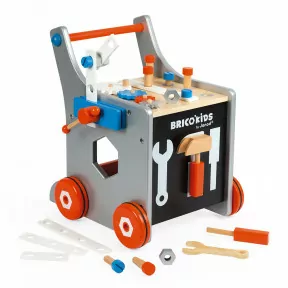
Brico'Kids Magnetic Diy Trolley (wood)
Do your little ones want to imitate their crafty parents? Here is a beautiful wooden DIY trolley with 25 accessories specially designed for children aged 18 months to 3 years! It will allow them to assemble and disassemble objects endlessly, according to their imagination. Your budding tinkerer will spend many hours designing and building his own inventions. The trolley has a magnetic tool system to help your child store their tools and an anti-tilt system to keep them safe. With this DIY set you will find 4 nails, 4 screws, 4 nuts, 6 inserts, 3 magnetic tools, a vice and a gear system with 4 wheels. The trolley is robust thanks to the metal wheel axles.
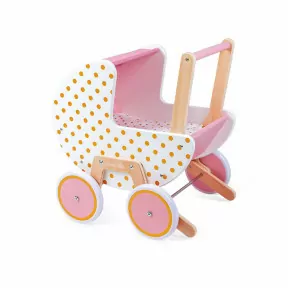
Candy Chic Pram
Dolls are bound to be sitting comfortably in this beautiful pram from Candy Chic collection, complete with its pink colour scheme and gold trim! Babies aged 18 months and over can push it along just like a real pram as they take their beloved babies on their first walks outside. It’s all baby needs to imitate mum, dad or a nanny when out for a walk. The silent rubber wheels won’t leave marks on floors. To keep your child safe, the Candy Chic pram is equipped with a stabiliser system that you can take off once your child feels more confident on their feet. The pram comes with a blanket and pillow to keep comforters and dolls warm and comfy. The pram features metal axles for added strength, as well as a pink fabric hood. Self-assembly toy. Suitable for dolls up to up to 42 cm tall (not included).

Sweet Cocoon Wooden Multi-Activity Trolley
This beautiful multi-activity push-along trolley is great for helping children learn to walk. It’s suitable for children aged 12 months and over, and comes with an invisible, removable brake that allows you to stop and release the wheels as required, so you can control the speed of the trolley as your child learns. As well as helping your child get on their feet, the trolley also gives your child 9 different ways to test their motor skills and dexterity: an abacus, a shape box, a maze, gears, a rotary switch with built-in sound, a “scratchy” button, a magnifying rotary mirror, a drum, and metal xylophone to develop their musical ear. And with its felt mat to reduce the noise of falling blocks and its silent wheels, our designers really have thought of everything! Given all that and its trendy design, you and baby are bound to love it! We love this early-years trolley’s natural wood and the white and grey colour scheme, which is accentuated by the splashes of colour that come with the nine different activities! The Sweet Cocoon collection features toys for infants with soft colours and rounded shapes, providing a wide range of fun activities that will keep babies and toddlers entertained for hours!
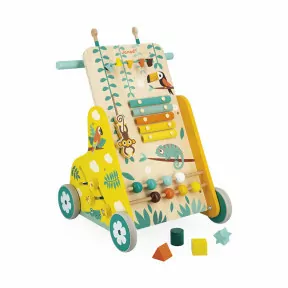
Tropik - Multi-Activity Trolley
Off to discoveries in the heart of the tropical jungle! With this wooden multi-activity wagon, children from 12 months will have hours of fun! Ideal for accompanying baby as they learn to walk, this colorful wooden wagon will become the perfect companion for their first adventures. This wagon is silent thanks to the rubber coating on the wheels. 6 activities are available for even more discoveries and games: abacuses, a shape sorter, an adorable monkey to slide, a maze, beads to slide, and a xylophone! To stimulate baby and support their development, from 1 year old. Practical, the two wooden sticks of the xylophone slide onto the top of the wagon so they don't get lost and can be taken everywhere! This vibrantly styled walking wagon will delight the whole family! Wooden wagon from sustainably managed, FSC®-certified forests. Water-based paint.
☼ Take off immediately for warm and colorful horizons with the TROPIK range from Janod: joyful and endearing animals in fun and vibrant colors, for exotic games and toys that invite you to escape!
➡️ How to choose the right walking cart for your child: our guide to making the right choice.
A cart for a child aged 2 to 3
At 2 years of age, your child may be able to walk unaided, but he still has plenty to discover! A multi-activity walking cart will enable him to develop his fine motor skills and imagination, while still being able to take his cart everywhere. The walking cart with games is ideal for stimulating all baby's senses up to the age of 3.
To support baby's motor development and awaken his senses through assembly activities, shapes, cubes and even loops, choose an evolving toy with a 2-in-1 walking cart!
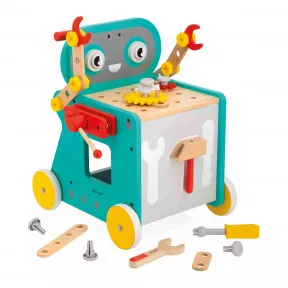
Brico'Kids Robot Trolley
Say “Hello” to our funny robot! With this robot-shaped activity cart, babies aged 18 months and up can have fun tinkering. A whole host of learning opportunities are made available to them, from fine motor skills to imagination and imitation! This early-learning toy is full of surprises: 3 magnetic tools on the front, a vice on the side and even a storage space in the centre! Ultra-practical for tinkering and pushing around. This magnetic baby cart contains 38 DIY accessories: 18 wooden accessories (boards and gears) and 20 plastic accessories (screws, nuts, nails). And that’s not all... the screws are equipped with notches for added realism. Another advantage to this early-years toy is the assemblable articulated robot arms on either side of the cart: the robot come to life, thanks to your little ones’ hands, and become their new play friend. It will be their first ultra-fun and colourful construction game! This wooden cart also serves as a workbench to let your child tinker whenever they please. They will develop their fine motor skills and creativity through play! Red, green, yellow and natural wood: this activity cart will introduce the whole family to the world of DIY robotics. Baby can screw, turn, lift, drop and much more with learning-focused manipulations! This magnetic baby cart is made from FSC™-certified wood and is part of our collection of pretend play DIY toys: Brico'Kids.

Tropik - Multi-Activity Trolley
Off to discoveries in the heart of the tropical jungle! With this wooden multi-activity wagon, children from 12 months will have hours of fun! Ideal for accompanying baby as they learn to walk, this colorful wooden wagon will become the perfect companion for their first adventures. This wagon is silent thanks to the rubber coating on the wheels. 6 activities are available for even more discoveries and games: abacuses, a shape sorter, an adorable monkey to slide, a maze, beads to slide, and a xylophone! To stimulate baby and support their development, from 1 year old. Practical, the two wooden sticks of the xylophone slide onto the top of the wagon so they don't get lost and can be taken everywhere! This vibrantly styled walking wagon will delight the whole family! Wooden wagon from sustainably managed, FSC®-certified forests. Water-based paint.
☼ Take off immediately for warm and colorful horizons with the TROPIK range from Janod: joyful and endearing animals in fun and vibrant colors, for exotic games and toys that invite you to escape!
➡️ How to choose the right walking cart for your child: our guide to making the right choice.

Brico'Kids Magnetic Diy Trolley (wood)
Do your little ones want to imitate their crafty parents? Here is a beautiful wooden DIY trolley with 25 accessories specially designed for children aged 18 months to 3 years! It will allow them to assemble and disassemble objects endlessly, according to their imagination. Your budding tinkerer will spend many hours designing and building his own inventions. The trolley has a magnetic tool system to help your child store their tools and an anti-tilt system to keep them safe. With this DIY set you will find 4 nails, 4 screws, 4 nuts, 6 inserts, 3 magnetic tools, a vice and a gear system with 4 wheels. The trolley is robust thanks to the metal wheel axles.

Multi-Activities Cat Baby Walker (wood)
Meooow! Make room for the cutest feline of them all! Our wide-eyed ginger cat is always ready for a walking and exploring session with baby! This wooden multi-activity baby walker will accompany children from 1 year old thanks to the many little games on its 3 sides! Have fun and develop your fine motor skills and dexterity with the 8 playful activities of our clever cat: a fish loop, a traditional shape sorter and a small mouse slider on the front, a mouse track on one side, gears and a seabed sound button on the other. To develop children's sense of touch, our cat's large eyes rotate and its cheeks are made of felt. This lovely multi-activity walker is particularly suitable for learning to walk; thanks to its height-adjustable handle (from 47 to 53 cm/18.5 to 20.9"), this walker can adapt to your child's height, and can therefore be used from 12 months to 3 years old. For more safety, it is equipped with an invisible and removable brake that allows the wheels to be locked and gradually released in order to control the speed of the walker during learning (suitable for 12 months old children). Finally, its 4 silent rubber wheels don't mark the ground! All you'll have to do is to name this new companion!
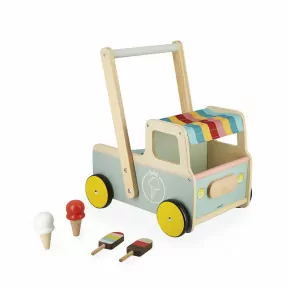
Ice Cream Cart Push-Along Trolley
Would you prefer sorbet or ice cream? The ice cream seller is coming to town, you'll have to make up your mind quickly! This wooden walker is as delicious as can be and is suitable for children from 12 months. To our great pleasure they discover walking with this truck-shaped cart in pastel colours and its accessories! With 4 ice creams included, there will be something for everyone. These little treats will find their place in the storage area at the back of the cart, a second storage bin is also accessible at the front. Handy for taking a cuddly friend for a walk, isn't it? Equipped with silent wheels, this early learning toy is 2 in 1: ideal for helping baby learn to walk, it is also an imitation toy that allows him to imagine himself as a little street vendor! Children from 1 year old will be able to offer ice creams throughout the day, a good way to interact and share some delicious moments. With its fresh design, mixing natural wood and stylish colours, this walker will look great in baby’s world (and his parents’)! It's summer all year round with this adorable wooden walking cart! Water-based paint, fabric roof, wood from sustainably managed, FSC®-certified forests.
If you're thinking of a draisienne carrier, or if your child is too big for a carrier or cart, it may be time to switch to a child's draisienne!
Ideal for developing balance and keeping up with older children on 2 wheels, the draisienne also enables children to make the transition to cycling more serenely later on. Whether indoors or outdoors, if your child has mastered walking, he or she is sure to have fun with a wooden draisienne from the age of 2!
To find out all about the many advantages of the draisienne and how to choose the right one, follow the guide!
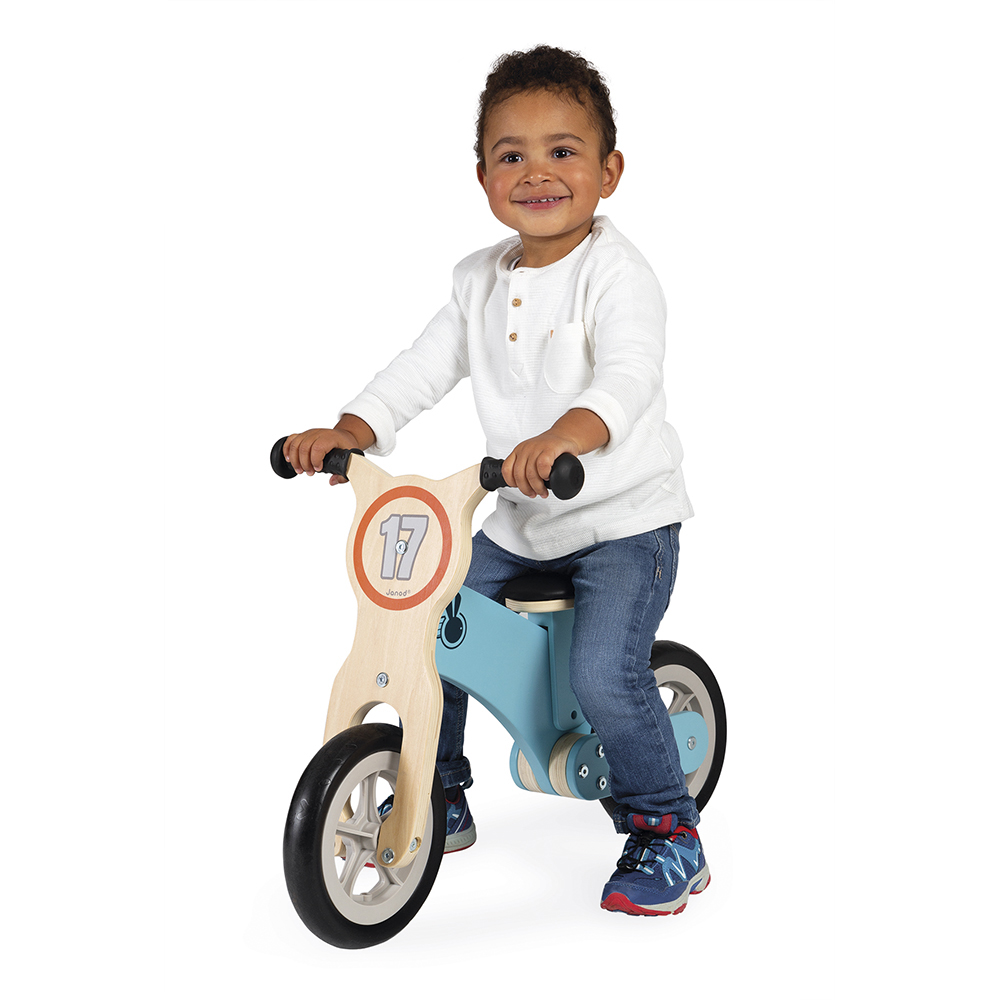
All that's left is to find the frame that will encourage baby to get moving!
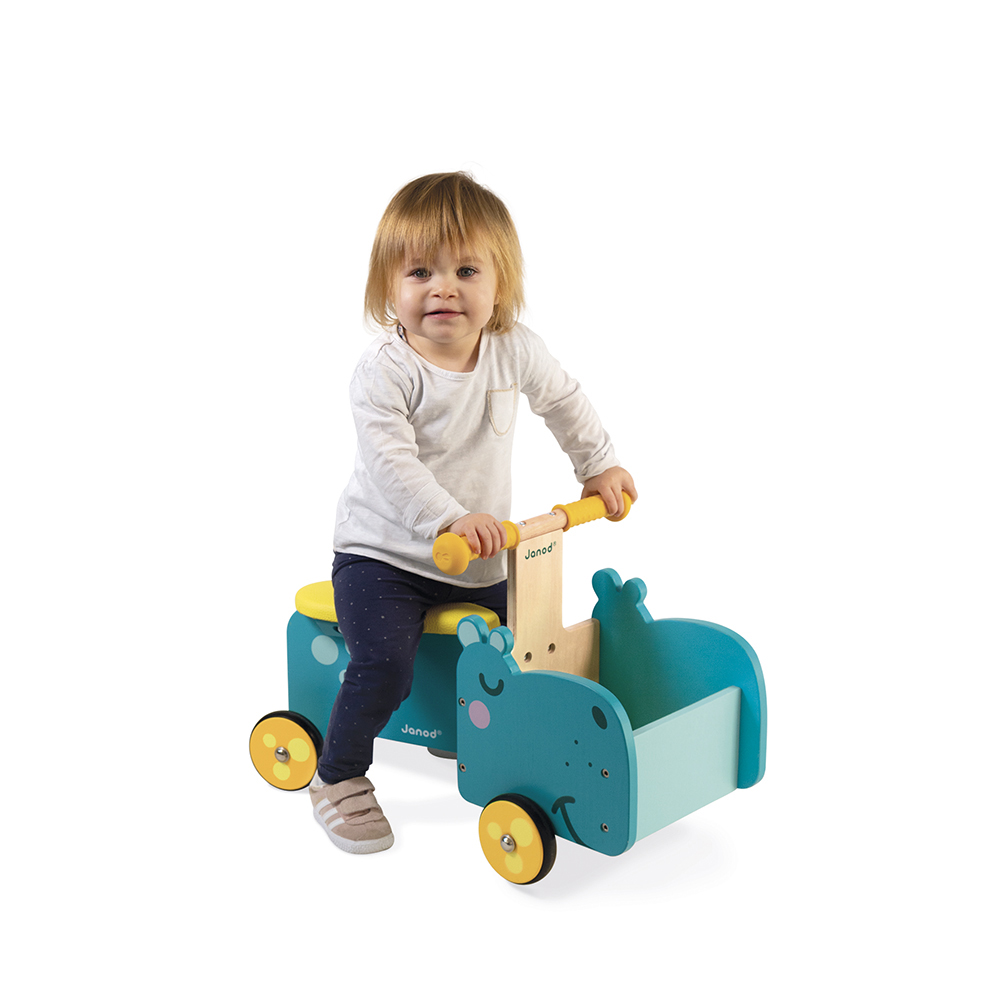
Every carrier is ready to join the family! Animal or vehicle, with directional wheels or integrated games: find the model that suits you and baby's tastes in our collection!
It's time to discover: find the walking cart that meets all your criteria and that will keep baby amused for hours from among those in our collection!
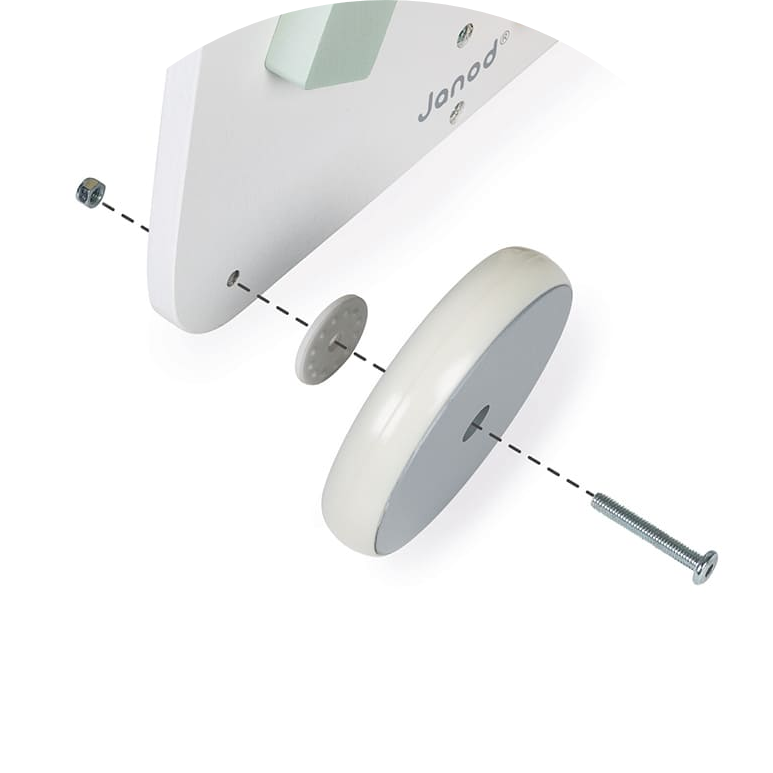 For even greater safety, especially for the youngest, choose a carrier or walking cart with brakes to control speed and avoid falls.
For even greater safety, especially for the youngest, choose a carrier or walking cart with brakes to control speed and avoid falls.
Sometimes adjustable, or even removable, the brakes allow free movement as the child progresses.
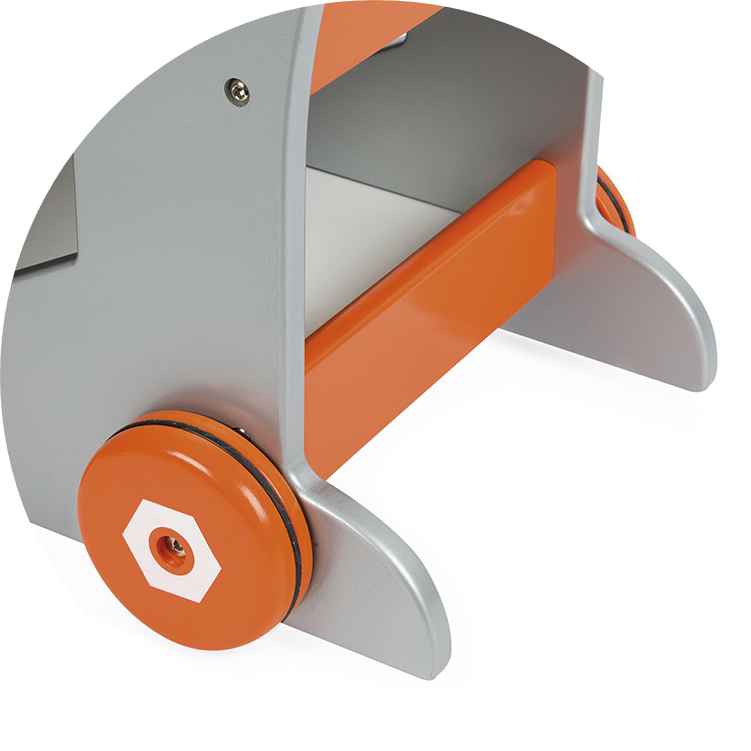 If baby puts all his weight on his cart or carrier and it tips over, this can be dangerous.
If baby puts all his weight on his cart or carrier and it tips over, this can be dangerous.
Check for the presence of an anti-tilt device, usually on the back of the toy.
It's the best way to ensure that baby's explorations don't echo throughout the house!
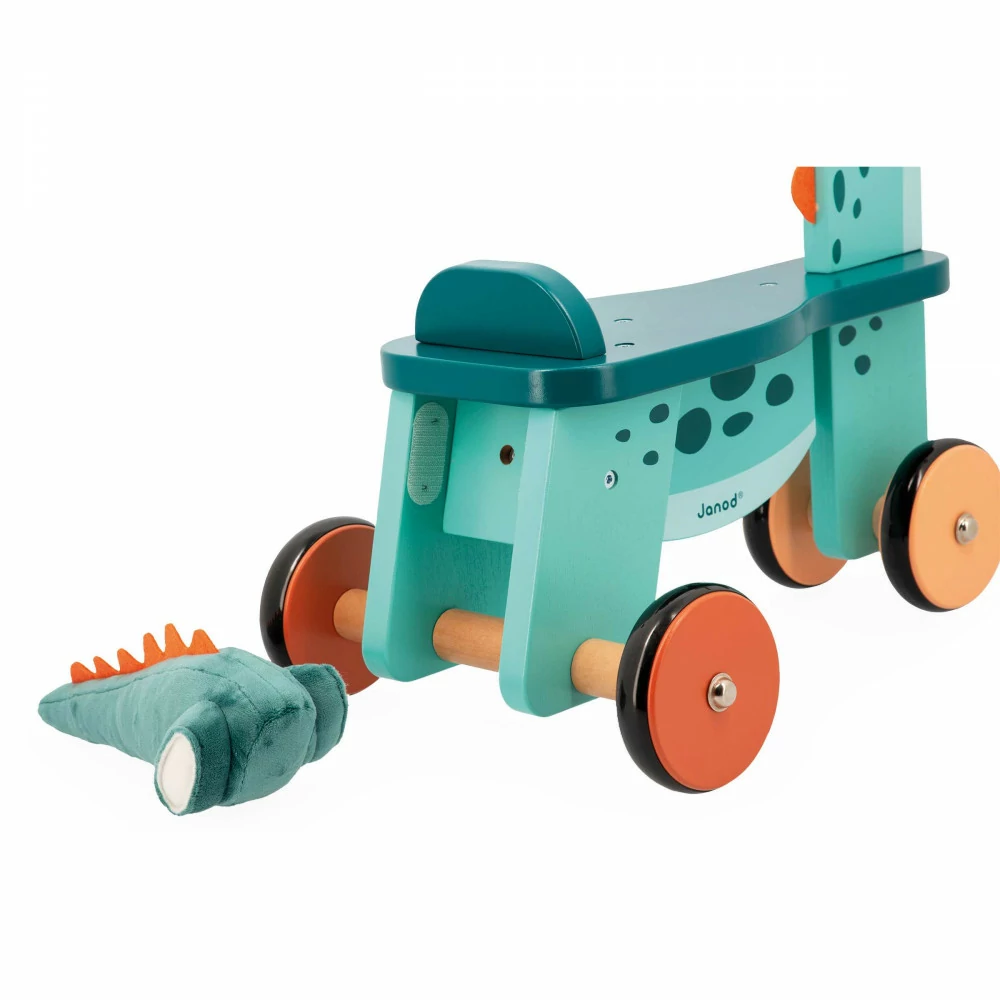 To ensure that baby never tires of his walking cart or carrier, choose a toy with a variety of activities to stimulate his senses: shape box, sound function, etc.
To ensure that baby never tires of his walking cart or carrier, choose a toy with a variety of activities to stimulate his senses: shape box, sound function, etc.
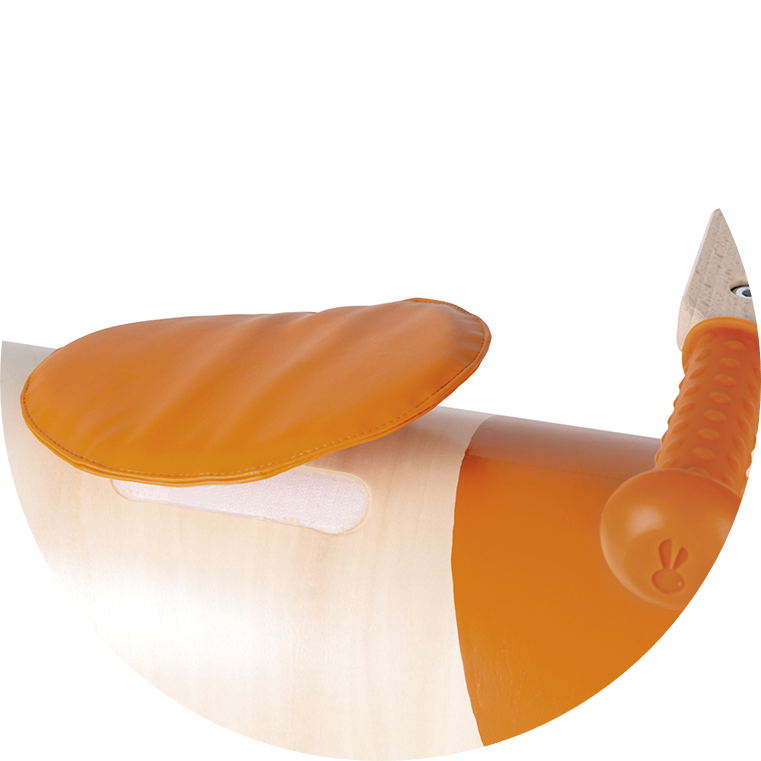 In addition to providing comfort for baby's many walks in the carrier, a removable seat makes it easy to clean in the event of a small diaper leak: parents are happy!
In addition to providing comfort for baby's many walks in the carrier, a removable seat makes it easy to clean in the event of a small diaper leak: parents are happy!
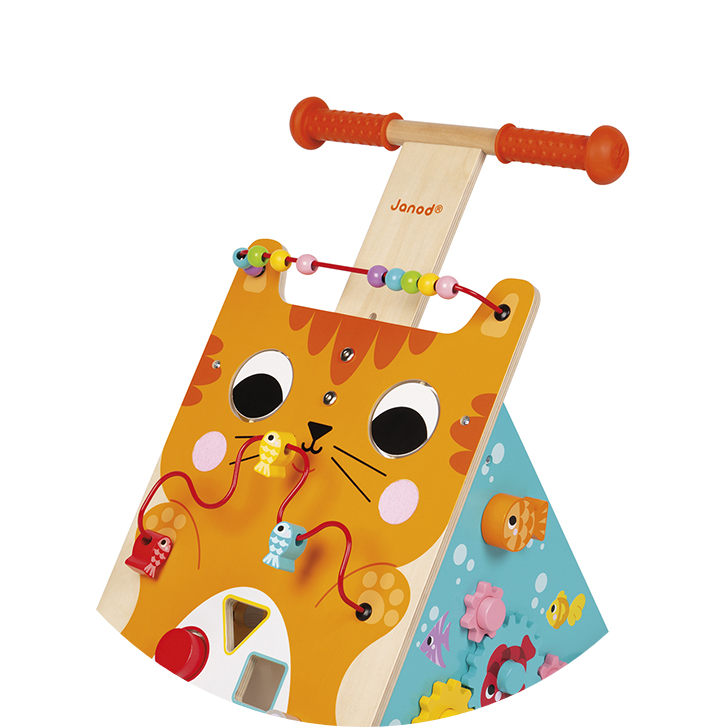 Even if it's not the same upheaval as adopting a real pet, baby's carrier will be brand new to him and, from his point of view, it will be big and fat! Choose contrasting colors to arouse baby's curiosity and encourage him to handle his carrier.
Even if it's not the same upheaval as adopting a real pet, baby's carrier will be brand new to him and, from his point of view, it will be big and fat! Choose contrasting colors to arouse baby's curiosity and encourage him to handle his carrier.
Animals and vehicles are often represented in baby's early-learning toys: find the animal he'll fall in love with, or the vehicle he'll be eager to drive!
For even greater safety, especially for the youngest, choose a carrier or walking cart with brakes to control speed and avoid falls. Sometimes adjustable, or even removable, the brakes allow free movement as the child progresses.
If baby puts all his weight on his cart or carrier and it tips over, it could be dangerous. Check for the presence of an anti-tilt device, usually on the back of the toy.
It's the best way to ensure that baby's explorations don't echo throughout the house!
To ensure that your baby never tires of his walking cart or carrier, choose a toy with a variety of activities to stimulate his senses.
In addition to providing comfort for baby's many walks in the carrier, a removable seat makes it easy to clean in the event of a small diaper leak: parents are happy!
Even if it's not the same upheaval as adopting a real pet, baby's carrier will be brand new to him and, from his point of view, it will be big and fat! Choose contrasting colors to arouse baby's curiosity and encourage him to handle his carrier.
Animals and vehicles are often represented in baby's early-learning toys: find the animal he'll fall in love with, or the vehicle he'll be eager to drive!
Wooden carriers and carts: adopted by babies and approved by parents!
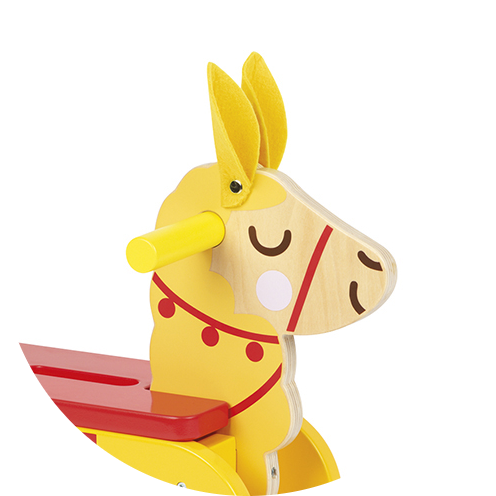


Are you worried that your child is too late for walking? At 10 months, some children already feel the need to stand up, a sign that the arrival of walking is just around the corner. Should you start encouraging them to do this so early, and how can you help those who are already confident?
Gaëlle, our early childhood expert, gives you a few tips and tricks to answer your questions and help your child progress at his or her own pace.
